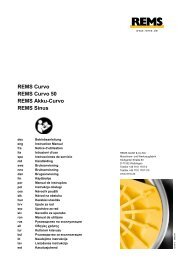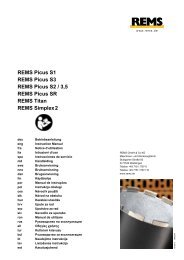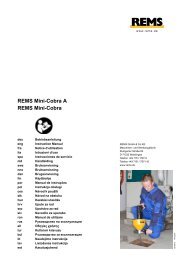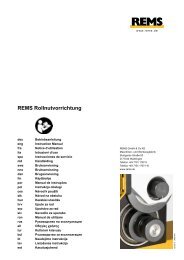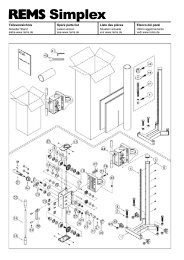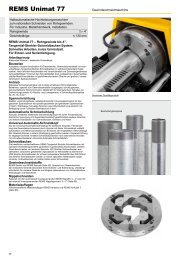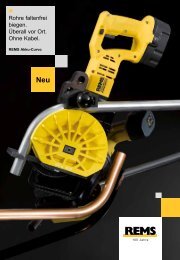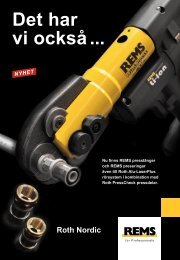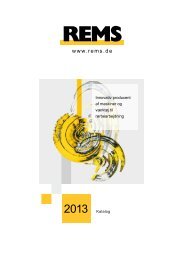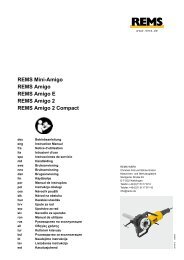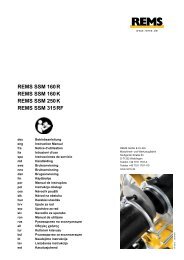Create successful ePaper yourself
Turn your PDF publications into a flip-book with our unique Google optimized e-Paper software.
eng<br />
Translation of the Original Instruction Manual<br />
Fig. 1– 8<br />
1 Cutting wheel drive<br />
2 Cutting wheel<br />
3 Rollers<br />
4 Holes for stand<br />
(only <strong>REMS</strong> <strong>Cento</strong>)<br />
5 Pipe<br />
6 Feed lever<br />
7 Safety foot switch<br />
8 Spindle<br />
General Power Tool Safety Warnings<br />
9 Spring plug<br />
10 Height adjustable pipe rest<br />
Ø 100 – 225 mm<br />
11 Clamping lever<br />
12 <strong>REMS</strong> REG 28-108<br />
13 <strong>REMS</strong> REG 10-54 E<br />
14 Roller insert for cutting pipes<br />
Ø 40 – 100 mm (accessory,<br />
only <strong>REMS</strong> Due<strong>Cento</strong>)<br />
WARNING<br />
Read all safety warnings and all instructions. Failure to follow the warnings and<br />
instructions may result in electric shock, fire and/or serious injury.<br />
Save all warnings and instructions for future reference.<br />
The term "power tool" in the warnings refers to your mains-operated (corded) power<br />
tool or battery-operated (cordless) power tool.<br />
1) Work area safety<br />
a) Keep work area clean and well lit. Cluttered or dark areas invite accidents.<br />
b) Do not operate power tools in explosive atmospheres, such as in the presence<br />
of flammable liquids, gases or dust. Power tools create sparks which<br />
may ignite the dust or fumes.<br />
c) Keep children and bystanders away while operating a power tool. Distractions<br />
can cause you to lose control.<br />
2) Electrical safety<br />
a) Power tool plugs must match the outlet. Never modify the plug in any way.<br />
Do not use any adapter plugs with earthed (grounded) power tools. Unmodified<br />
plugs and matching outlets will reduce risk of electric shock.<br />
b) Avoid body contact with earthed or grounded surfaces, such as pipes,<br />
radiators, ranges and refrigerators. There is an increased risk of electric shock<br />
if your body is earthed or grounded.<br />
c) Do not expose power tools to rain or wet conditions. Water entering a power<br />
tool will increase the risk of electric shock.<br />
d) Do not abuse the cord. Never use the cord for carrying, pulling or unplugging<br />
the power tool. Keep cord away from heat, oil, sharp edges or moving<br />
parts. Damaged or entangled cords increase the risk of electric shock.<br />
e) When operating a power tool outdoors, use an extension cord suitable for<br />
outdoor use. Use of a cord suitable for outdoor use reduces the risk of electric<br />
shock.<br />
f) If operating a power tool in a damp location is unavoidable or there is the<br />
likelihood of cutting into the cord, use a residual current device (RCD)<br />
protected supply. Use of an RCD reduces the risk of electric shock.<br />
3) Personal safety<br />
a) Stay alert, watch what you are doing and use common sense when operating<br />
a power tool. Do not use a power tool while you are tired or under the influence<br />
of drugs, alcohol or medication. A moment of inattention while operating<br />
power tools may result in serious personal injury.<br />
b) Use personal protective equipment. Always wear eye protection. Protective<br />
equipment such as dust mask, non-skid safety shoes, hard hat, or hearing protection<br />
used for appropriate conditions will reduce personal injuries.<br />
c) Prevent unintentional starting. Ensure the switch is in the off-position before<br />
connecting to power source and/or battery pack, picking up or carrying the<br />
tool. Carrying power tools with your finger on the switch or energising power<br />
tools that have the switch on invites accidents.<br />
d) Remove any adjusting key or wrench before turning the power tool on. A<br />
wrench or a key left attached to a rotating part of the power tool may result in<br />
personal injury.<br />
e) Do not overreach. Keep proper footing and balance at all times. This enables<br />
better control of the power tool in unexpected situations.<br />
f) Dress properly. Do not wear loose clothing or jewellery. Keep your hair and<br />
clothing away from moving parts. Loose clothes, jewellery or long hair can be<br />
caught in moving parts.<br />
g) If devices are provided for the connection of dust extraction and collection<br />
facilities, ensure these are connected and properly used. Use of dust collection<br />
can reduce dustrelated hazards.<br />
4) Power tool use and care<br />
a) Do not force the power tool. Use the correct power tool for your application.<br />
The correct power tool will do the job better and safer at the rate for which it was<br />
designed.<br />
b) Do not use the power tool if the switch does not turn it on and off. Any power<br />
tool that cannot be controlled with the switch is dangerous and must be repaired.<br />
c) Disconnect the plug from the power source and/or the battery pack from<br />
the power tool before making any adjustments, changing accessories, or<br />
storing power tools. Such preventive safety measures reduce the risk of starting<br />
the power tool accidentally.<br />
d) Store idle power tools out of the reach of children and do not allow persons<br />
unfamiliar with the power tool or these instructions to operate the power<br />
eng<br />
tool. Power tools are dangerous in the hands of untrained users.<br />
e) Maintain power tools. Check for misalignment or binding of moving parts,<br />
breakage of parts and any other condition that may affect the power tool’s<br />
operation. If damaged, have the power tool repaired before use. Many<br />
accidents are caused by poorly maintained power tools.<br />
f) Keep cutting tools sharp and clean. Properly maintained cutting tools with<br />
sharp cutting edges are less likely to bind and are easier to control.<br />
g) Use the power tool, accessories and tool bits etc. in accordance with these<br />
instructions, taking into account the working conditions and the work to<br />
be performed. Use of the power tool for operations different from those intended<br />
could result in a hazardous situation.<br />
h) Keep handles dry, clean and free from oil and grease. Slippery handles do<br />
not allow for safe handling and control of the tool in unexpected situations.<br />
5) Service<br />
a) Have your power tool serviced by a qualified repair person using only<br />
identical replacement parts. This will ensure that the safety of the power tool<br />
is maintained.<br />
Safety instructions for pipe cutting machines<br />
WARNING<br />
Read all safety warnings and all instructions. Failure to follow the warnings and<br />
instructions may result in electric shock, fire and/or serious injury.<br />
Save all warnings and instructions for future reference.<br />
● Do not overload the pipe cutting machine, the cutting wheel and the pipe<br />
by too high feeding pressure on the feed lever (6). The pipe cutting machine<br />
and the cutting wheel are subject to heavier wear by too high feeding pressure<br />
and can be damaged. At too high feeding pressure, the ends of the pipe to be<br />
cut are pressed further inwards causing constriction of the cross section. Pipes<br />
made of brittle material, e.g. cast pipes, can be fractured or broken by too high<br />
feeding pressure.<br />
● Do not reach into moving parts in the cutting and deburring area and in the<br />
area of the rollers (3) and height adjustable pipe rests (10). There is a risk<br />
of injury by crushing fingers or hands.<br />
● Use <strong>REMS</strong> Herkules 3B (Art. No. 120100), <strong>REMS</strong> Herkules Y (Art. No. 120130)<br />
material rest(s) or the height adjustable pipe rest(s) (10) to support long<br />
pipes at both ends if necessary and align these exactly to the rollers (3) of<br />
the cutting machine. This reduces off-centre running of the pipes and the cut<br />
pipes do not fall onto the floor.<br />
● Check that the pipes are running true before cutting them. Cutting pipes that<br />
are not straight causes imbalance and the pipe or pipe rest can fall over. The<br />
pipe can also slip off the material or pipe rest, the pipe cutting machine can move<br />
and the cutting wheel can be damaged. Danger of injury.<br />
● Only move or carry the <strong>REMS</strong> Due<strong>Cento</strong> by the feed lever (6) when this has<br />
been locked as described in 2.2. If the feed lever is not locked there is a danger<br />
that the feed lever (6) will come away from the spindle (8). <strong>REMS</strong> Due<strong>Cento</strong> can<br />
then fall over or fall off. Danger of injury.<br />
● Protect persons accompanying the work against the rotating pipe during<br />
cutting. Danger of injury.<br />
● Check the mains lead and any extension cables of the pipe cutting machine<br />
regularly. Have these renewed by qualified experts or an authorised <strong>REMS</strong><br />
customer service workshop in case of damage.<br />
● Only allow trained persons to use the pipe cutting machine. Apprentices<br />
may only use the pipe cutting machine when they are over 16, when this is<br />
necessary for their training and when they are supervised by a trained operative.<br />
● The pipe cutting machine is not intended for use by persons (including children)<br />
with reduced physical, sensory or mental capabilities or lack of experience and<br />
knowledge unless they have been given supervision or instruction concerning<br />
the use of the pipe cutting machine by a person responsible for their safety.<br />
Children must be supervised to ensure that they do not play with the pipe cutting<br />
machine.<br />
Explanation of symbols<br />
WARNING<br />
CAUTION<br />
NOTICE<br />
Danger with a medium degree of risk which could result in<br />
death or severe injury (irreversible) if not heeded.<br />
Danger with a low degree of risk which could result in minor<br />
injury (reversible) if not heeded.<br />
Material damage, no safety note! No danger of injury.<br />
Read the operating manual before starting<br />
Electrical device complies with protection class II<br />
Environmental friendly disposal




